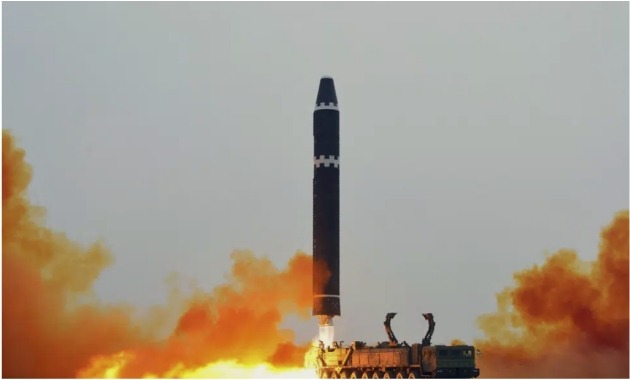
North Korea tests ICBM, North Korea said its latest intercontinental ballistic missile (ICBM) test on February 12 was meant to further strengthen its “fatal” nuclear attack capacity against its rivals. In response, the United States flew long-range supersonic bombers later on Sunday.
In a joint exercise with South Korean warplanes to demonstrate strength against North Korea. Saturday’s ICBM test, the North’s first missile test since January 1, signals that North Korean leader Kim Jong Un is using the military drills of his rivals to expand his country’s nuclear arsenal to gain the upper hand in future dealings with the United States. An expert says North Korea may seek to hold regular operational exercises involving its ICBMs.
North Korea’s official Korean Central News Agency (KCNA) said its launch of the Hwasong-15 ICBM was organized “suddenly” without prior notice at Kim’s direct order. KCNA said the launch was designed to verify the weapon’s reliability and the combat readiness of the country’s nuclear force.
It said the missile was fired at a high angle and reached a maximum altitude of about 5,770 km, flying a distance of about 990 km for 67 minutes before accurately hitting a pre-set area in the waters between the Korean Peninsula and Japan.
The steep-angle launch was apparently to avoid neighbouring countries. The flight details reported by North Korea, which roughly matched the launch information previously assessed by its neighbours, show the weapon is theoretically capable of reaching the mainland US if fired at a standard trajectory.
The North Korea tests Hwasong-15 ICBM and its launch demonstrated the North’s “powerful physical nuclear deterrent” and its efforts to “turn its capacity of fatal nuclear counterattack on the hostile forces” into an extremely strong one that cannot be countered, KCNA said.
The North is pushing to build a solid-fuelled ICBM, which would be more mobile and harder to detect before its launch. Whether North Korea has a functioning nuclear-tipped ICBM is still a source of outside debate, as some experts say the North hasn’t mastered a way to protect warheads from the severe conditions of atmospheric reentry. The North says it has acquired such technology.
North Korea is sensitive to the deployment of US B-1B bombers, which are capable of carrying a huge payload of conventional weapons. The North’s launch came a day after it vowed an “unprecedentedly” strong response over a series of military drills that Seoul and Washington plan in the coming weeks.
In a statement on February 13, Kim Yo Jong, the influential sister of Kim Jong Un, accused South Korea and the US of “openly showing their dangerous greed and attempt to gain the military upper hand and predominant position in the Korean Peninsula.” “I warn that we will watch every movement of the enemy and take corresponding and very powerful and overwhelming counteraction against its every move hostile to us,” she said.
North Korea has steadfastly slammed regular South Korea-US military drills as an invasion rehearsal, although the allies say their exercises are defensive in nature. The South Korean and US militaries plan to hold a tabletop exercise this week to hone a joint response to a potential use of nuclear weapons by North Korea. The allies are also to conduct another joint computer-simulated exercise and field training in March.
US National Security Council spokesperson Adrienne Watson said the US will take all necessary measures to ensure the security of the American homeland and South Korea and Japan. South Korea’s presidential National Security Council said it will seek to strengthen its “overwhelming response capacity” against potential North Korean aggression based on the military alliance with the United States.
